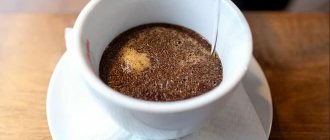Sand coffee or Turkish coffee is a drink listed as a UNESCO Intangible Cultural Heritage, but despite its big name, you can make it quite easily at home. Making coffee on sand is a whole ritual, a bit of a sacred act, and yet everything is so simple that anyone can do it (in a sense, more convenient than on a stove). We'll tell you what's so special about this drink and how to make sand coffee at home.
Types of sand coffee equipment
The devices differ in different ways: there are systems for the home or restaurant that run on electricity or require external heating, as well as special coffee makers. We will look at a variety of options, from fairly simple to the most interesting.
You only need to delve into the parameters if you are taking professional equipment; For a home, power and temperature are not so important; here it is rather more convenient to take a set for coffee on the sand.
East is a delicate matter
Considering the human tendency to always improve everything, such authenticity is a rarity, especially when it comes to food and drinks.
The very phrase “coffee on sand” can mislead a person who has never seen how a drink is prepared in this way. So, this does not mean at all that whole or ground coffee beans are covered with fine grains of sand. This means that golden sand crystals are used to uniformly heat the cezve. When brewing coffee in a Turk on the stove, it is very difficult to ensure uniform heating of the container. Whereas coffee on sand means that the cezve is heated from both the bottom and the sides.
Coffee prepared on sand differs from coffee prepared in a Turk on a stove in both a richer taste and a richer aroma..
Return to content
Electric machines for brewing coffee on sand
All such devices look and work on the same principle: it is a round or rectangular box with a built-in or attached container of sand. The device is connected to a 220V power supply and heats the sand. Proper thermal protection protects the surface on which the device stands from heating or damage.
- On average about 1 kW is consumed.
- Temperature adjustment 50–300 degrees.
- Sand is usually included.
You can buy a machine for making coffee on sand for one Turk and for 3-4 or even more at the same time.
Sometimes the Turks come in a set, then it turns out to be a set. Estimated cost:
- Grill Master F1KFE – 11,500 rubles;
- EPK different models - 11,000–12,000 rubles;
- Food Technologies APK-V-4 – 8000 rub.
Equipment from Russian manufacturers can be found very inexpensively.
Sand coffee machines Johny
The principle of operation of such devices is the same, but they should be considered separately. The fact is that this device is, of course, functional, but first of all – incredibly beautiful. This is a Greek brand, and traditionally Greeks brew coffee the same way as Turks. That is, Turkish coffee and Greek coffee are the same.
- Built-in thermostat and precise temperature control.
- Aluminum heating element for quick start.
- Uniform heating.
- Protection of walls and bottom, no risk of burns.
- There is an emergency switch if the sand overheats.
The most popular models from the manufacturer are Johny AK/8-3 for daily work and Johny AK/8-2 to impress guests (100% attracts attention).
Approximate prices for popular models:
- Johny 8-5 Gold – 14,000 rubles;
- Johny 8-3 N – 21,000 rubles;
- Johny 8-2 – 45,000 rub.
Look for discounts and promotions, this is a luxury brand and prices are often inflated.
How to serve
Traditionally, Turkish coffee is poured into small porcelain cups and served to guests on a large round tray along with oriental sweets - halva, marmalade, baklava, marshmallows, candied fruits. To further improve the quality of the drink, it is better to warm up the cups in advance (pour boiling water over them).
You need to drink Turkish coffee in small sips, slightly holding the drink in your mouth to feel the maximum of its taste. After each sip, it is recommended to take a sip of clean, cool water. It washes the taste buds, and the subsequent sip of coffee is perceived in all its flavor and aroma. Water is not a requirement, but only a recommendation.
Sand coffee makers without sand
Interestingly, to make Turkish coffee, sand in a coffee maker is not so necessary. Some brands produce coffee makers with the “effect” of sand coffee, with a special heating mechanism. No cezves are used, there is no need to monitor the process.
- Pouring into cups or jugs.
- Induction heating, foam falls and rises.
- The foam is like real oriental coffee.
- The same languor.
- No human intervention is required.
An ideal option for preparing classic Turkish coffee from finely ground grains with fluffy foam, but without the risk that the drink will run away or boil, all in automatic mode.
Average cost:
- BEKO BKK 2300 – for 1 “Turk” – 11,000 rubles;
- BEKO BKK 2113 – for 2 Turks – 16,000 rubles;
- ARZUM OKKA – for 1 or 2 cups – 30,000 rub.
Almost all brands and models that produce such coffee makers are Turkish, they understand this.
Cooking process
Take a roasting pan and add sand.
Place the frying pan on the heat and wait until the entire ball of sand is completely heated. Stir it occasionally.
Take a cezve, add one to three teaspoons of coffee powder and pour 50 to 100 ml of cold, even ice-cold, water. If desired, at this stage of cooking you can add a few grains of salt or your favorite spices.
Dip the Turk into the sand as deeply as possible without reaching the bottom of the pan.
Brew the coffee (usually this takes about three minutes). As soon as you see that the foam begins to rise, remove the Turk. After a few seconds, return it to its place. Repeat this procedure three times. Carefully! The coffee will already begin to smell very fragrant, so control yourself and don’t lose hope of finishing it J
Pour boiling water over a coffee cup (to warm it up) and drain.
Carefully transfer the thick foam from the cezve into a cup. And now the most difficult part: you need to pour the coffee into the cup so that the foam rises to the top. To do this, slowly pour the liquid over the sides of the cup.
You can add 1 tsp to the finished coffee. cognac or whipped cream.
What is the best coffee to use?
Sets for making coffee on sand
Technically, even an electric device can be called a kit, since the kit often includes quartz sand and possibly cezves. But usually, sets mean something else. This is a home equipment to make coffee using sand on the stove. The set may include:
- A coffee roaster on sand is the same “frying pan”;
- Quartz sand - usually with a reserve, but you can always buy more;
- A spatula for mixing sand - you need it to heat up evenly;
- Spoon with a long handle;
- There are two cezves as standard, but options are possible.
Please note: there is no heating source, the roaster is placed on a heated stove (gas or electric), many models can even be used over an open fire.
Pros of buying a Turkish sand coffee set:
- Everything you need has already been collected by professionals. You unpack the kit and you can start cooking.
- All items match each other in style.
- The cezves and the depth of the roasting pan match each other exactly.
- High-quality metal does not deteriorate. This roaster can last for decades and even become a family heirloom.
- This is the perfect gift if you don't know what to give a coffee lover you know.
Estimated cost:
- Set for coffee on the sand “Tete a Tete” Tima – 4500 rubles;
- Gift set “Oriental” – 3600 rubles;
- Set “Stanitsa”, 4 Turks – 6800 rub.
If you already have a favorite Turk, you can buy the roasting pan separately.
Cooking without special equipment
It is not at all necessary to purchase equipment for your home to be able to brew Turkish coffee on sand yourself. A special frying pan can easily be replaced with an ordinary frying pan. It looks like this.
- You need to choose the right cookware. This should be a large frying pan with thick walls, high sides and no Teflon coating.
- Pour sand into the selected container and put on fire. In order for it to heat completely and evenly, it must be stirred constantly.
- While the sand is heating, prepare the coffee mixture. To emphasize the aroma of the drink, you can add spices or a small amount of salt.
- The cezve needs to be sunk in the sand so that its bottom does not touch the metal surface of the frying pan - this will disrupt the uniform heating of the drink and seriously affect its taste.
- Coffee is brewed in the standard way. Several times you need to make the foam rise and settle. It is important not to let the drink boil, this will ruin all your efforts.
You might be interested in Industrial and home coffee roasting
In any case, special attention should be paid to serving ready-made coffee on the table. It is necessary to prepare the coffee cups correctly. These can be special small dishes designed for ristretto or espresso, or regular small mugs. The cups must be heated by pouring boiling water over them, putting thick coffee foam into them and only then pouring a hot drink.
At the same time, the accuracy and clarity of all movements is very important so that the coffee turns out not only incredibly tasty, but also very beautiful. When serving, a glass of cool, clean water is usually added to it. Coffee connoisseurs claim that this is necessary to fully experience all the notes of the rich taste. You need to cleanse your taste buds with a small amount of water, and only then start drinking.
Where to buy sand for Turkish coffee
This is a consumable item, and you usually receive the first pack when you buy equipment or a kit. Most often, on the same website or in the same store, you can additionally buy sand for making coffee. It is better to have a package in reserve; there is always a risk of spilling or spilling it. Moreover, you will definitely need it anyway. You don’t need to change it very often; you yourself will understand when it changes its appearance.
Manufacturers recommend using quartz sand for coffee; it is cleaned and sifted, homogeneous, does not clump or cake.
If for some reason you don’t have the “correct” sand at hand, you can use regular river or sea sand, or even construction sand, just at a minimum, sift it, or better yet, calcinate it. After all, Eastern peoples have been cooking with ordinary sand for centuries, and no one has cleaned it.
You will not spoil even professional devices and equipment with sifted sand. There is only a risk of scratching the surface of the roasting pan with pebbles or shells, which is why cleaning is necessary.
Tips and recipes
Making coffee on sand.
One of the most common methods of brewing coffee today. Different sources called it differently - in Turkish, Arabic, Oriental, Greek. This type of coffee, depending on the amount of sugar used during its preparation, can be bitter, sweet, very sweet, thinner or thicker.
To prepare the drink, you need to use very finely ground coffee, almost dust . Firstly, fine grinding will guarantee abundant foaming, and secondly, the grounds will not squeak on your teeth. It's better to grind the grains yourself. Ground coffee loses essential oils quite quickly. For fine grinding, you must use a special coffee grinder.
Coffee is prepared in a special copper vessel with a long handle, called a cezve. Under no circumstances should coffee be boiled. Therefore, coffee is ideally prepared on hot sand .
In one of the preparation options (Arabic coffee), the Turks pour a little granulated sugar on the bottom and place it on the sand. When the sugar turns brown, add water. Be careful - if the sugar burns, the coffee will have a bitter taste. Sugar and coffee to taste are placed in the Turk, and hot water is poured in (preferably cold, but this violation of technology is not significant). They bury the Turk in the sand. The sand is hot at the bottom, but only warm at the top. After a couple of minutes foam appears. This is coffee foam, not water foam from boiling. The turk is removed from the sand or removed from the heat, depending on the method, and the foam is allowed to settle. Again they bury the Turk in the sand or put it on fire, again let the coffee foam rise, and repeat this several times. The method is quite labor-intensive and time-consuming. You can add cinnamon to your coffee.
Coffee is poured into small coffee cups without straining, with grounds . Cold water is supplied separately. If desired, you can add a few drops of water to the cup to help the grounds settle faster. It is customary to drink oriental coffee in small sips and wash it down with cold boiled water.
Why do they still use Turka?
Coffee machines and coffee makers have changed many times over the course of a century, acquiring new capabilities and improving, but the Turka (aka cezve, ibrik, rakva) has remained virtually unchanged for several centuries and has not lost its popularity. Why?
The fact is that the shape and material of the ancient vessel for brewing coffee are thought out to the smallest detail and perfectly preserve all the shades of taste and aroma of coffee. Is this not what a modern coffee machine/coffee maker strives for?
The kind of coffee you get in Turkish cannot be made anywhere else - aromatic, viscous, dense. The thick foam rivals the famous crema for espresso, and the strength of Turkish coffee surpasses even ristretto.
Is coffee brewed “with soul” (and this is exactly how it should be) comparable to making coffee even in the most fashionable coffee equipment, where the taste of the drink depends entirely on the capabilities of the machine and the quality of the coffee beans?
Oriental coffee or Turkish coffee
Drinking coffee in the Arab world is a ritual of special significance for both the host and the guest. The method of brewing coffee, developed in ancient times, has survived to this day almost in its original form. This method is becoming increasingly popular all over the world. The equipment for preparing such coffee is being improved, but the principle remains the same: we brew coffee on sand in a Turk (aka “ibrik”, “cezve”). Turks made of copper with a wooden handle are best suited for this. The sand should be very fine. Regular river water will not work. We select the type of coffee according to taste. A very important detail: the grinding must be very fine (“to dust”). There should be no grains.
There are many brewing methods. You can show your imagination by adding various spices to your coffee: cardamom, vanilla, cocoa, cinnamon, ginger, salt, pepper and others . But it is very important to keep it in moderation.
If you order Turkish coffee at a restaurant, it is advisable to warn the guest that it will take time to prepare (10-15 minutes).
Pour 10-12 grams of very finely ground coffee into a Turk (two heaped teaspoons). Add one or two teaspoons of granulated sugar. Fill with cold water (100-110 ml). The water must be purified (not from a tap). Mix with a long spoon and place in sand, which should be heated to 300 degrees. You can add heated water to the coffee, but not boiling water. As it heats up, foam begins to form around the edges of the drink. We wait until it completely covers the surface of the drink and begins to rise. The Turk needs to be removed, cooled a little and put back on the sand. When the foam rises a second time (maybe a third), the drink is ready. This brewing method involves obtaining as thick a foam as possible. It is necessary to pour the coffee so that the foam remains on the surface. It is recommended to serve this coffee with a glass of water. They drink coffee in small sips.
Turkish coffee
Do you think that Turkish coffee was first brewed in Turkey? Does the Arabica coffee tree come from Arab countries?
In fact, Arabica comes from Ethiopia (Africa), but it so happened that the tree of this variety became famous only after it began to be grown in Yemen (Arabia). It’s the same with Turkish coffee. Caravan workers from Western Asia and North Africa began to prepare it. And only then, thanks to them, this method of cooking came to Syria, and from there to Turkey.
In Turkey, it took root and gained popularity, after which they learned about it in other countries, already under the name “Turkish coffee”. In the classic version, it is a thick, viscous drink, sweet, black, with a thick, aromatic head of foam.
How is coffee prepared in Turkish?
It is prepared in a Turk, which is placed in hot sand. The grains are roasted before each preparation, often on the same sand, in a special small scoop. Previously, when Turkish soldiers went on a campaign, everyone had to have a coffee ladle, a Turk, a cup and a bag of coffee beans. Sometimes they didn’t even worry about provisions as much as they worried about coffee beans.
After roasting, the grains are still hot and ground into dust. In the classic version, this is done in a special mortar - just from the grinding process itself, “Turkish coffee” acquires a special taste. Now you need to pour cold water into the Turk, add sugar and place the cezve on the hot sand. As soon as the sugar has dissolved and the water has become almost hot, add coffee and stir so that the grains are thoroughly moistened.
Now you can immerse the Turk in the sand. As soon as the foam has risen to the level of the neck, the turkey is removed from the heat. Leave for a minute until the foam settles by two-thirds. Again they bury the Turk in the sand until foam appears. And repeat again.
Professionals extract coffee from the sand in such a movement that the foam itself seems to be pressed inward and the Turk is immediately immersed in the sand again. Sometimes the process is repeated 2 times, sometimes 5 or 6 times. This is already determined by the master based on his own characteristics. You can find out this yourself experimentally, in practice. Masters in Turkey say that after the 3rd hundred cups prepared, you already begin to “feel” the coffee.
Another important point: first, carefully remove the foam with a spoon so that almost all of it sticks to the spoon. This, by the way, is an indicator of proper preparation - if the foam does not spread, but stays on the spoon for a while. Then pour the coffee into the cup. And on the coffee we put the same cap of foam that we hold on the spoon. This matter requires some skill, because this procedure must be done quickly and simultaneously.
Yemeni Ginger Coffee Recipe
Let's take: 1 tbsp. l. finely ground coffee, a pinch of ground ginger or a piece of dry root (about 3 mm 3 mm), 75 ml of water, 1/2 coffee spoon of sugar. Preparing Yemeni coffee: In a Turk (cezva, ibrik) brew Arabic coffee with the addition of ginger. Immediately pour into cups and add sugar to taste.
Oriental coffee with spices
What we need for cooking: 2 tsp. finely ground coffee, 100 - 150 ml of water, a small piece of dry ginger (about a pinch), the same piece of nutmeg.
How to make spicy coffee: pour cold water into the cezve, add coffee and bring to a boil. Remove from heat, add spices, cover and leave for 5 - 7 minutes. Put it on the fire again and, as soon as a thick foam appears, remove and pour into cups.
Libyan Kahwa with cardamom and saffron
Ingredients: 1 tsp. with a slide of finely ground coffee, 1/4 coffee spoons of saffron powder, 2 cardamom grains, 60 ml of water.
Preparation: Pour coffee and cardamom into a pot, add water and bring to a boil twice. Add saffron, mix well and put on fire until a foamy cap appears. Serve in small cups.
Sicilian coffee - recipe for coffee with lemon
Ingredients for 1 serving: 1 tsp. coarsely ground coffee, 1 - 2 tsp. finely ground dark roast coffee, 100 ml water, juice from 1/2 medium lemon.
Preparation of Sicilian coffee: Mix two types of coffee and pour into a cezve. Brew Turkish coffee, add lemon juice to the coffee. Pour into cups with grounds.
Malay coffee with vanilla
1 tsp. ground coffee
- 2 tsp. Sahara
- 1 small piece of vanilla pod
- 100 ml. water
Boil water with sugar in a coffee pot or cezve When the syrup begins to actively boil, add a vanilla stick (real!) and remove from heat. After a minute, add ground coffee, stir and put on fire. As soon as the foam cap rises, immediately remove and strain into a cup.











